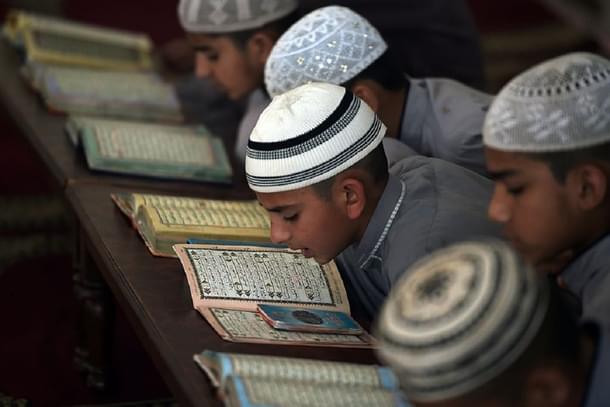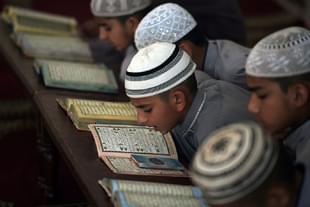Politics
Debate On Hindu Children In Madrassas: How A Child Separated From Family Was Found After Eight Years In An Islamic School
Swati Goel Sharma
Jul 21, 2024, 09:11 PM | Updated Jul 22, 2024, 01:11 PM IST
Save & read from anywhere!
Bookmark stories for easy access on any device or the Swarajya app.


It has been nearly 10 months since Virendra Kumar reunited with his son, who went missing in 2016.
Vijay (name changed to protect identity), then a Class V student, was on his way to school when he vanished without a trace.
Virendra embarked on a relentless search for his son, frequenting the local police station to follow up on the missing person's report he had filed and repeatedly questioning his son’s friends for any leads.
The search was fruitless.
As months turned into years and time dragged on, Virendra’s hopes began to diminish. He had given up on ever finding his child when he received an unexpected phone call in October. "Do you have a son named Vijay?" asked the voice on the other end of the line.
The call came from a police station in Uttar Pradesh’s Muzaffarnagar district, nearly 500 kilometres from Virendra's home in Hardoi district.
Overwhelmed with emotion, the father broke down. "I didn't know what to expect," Virendra, who is 50, recounted to Swarajya this week. "Had they found his body? Or was my son alive?"
To his immense relief, the officer informed him that Vijay was alive. However, he now went by the name Mohammed Umar, was living with a family in Muzaffarnagar, and was enrolled in a madrassa.
After confirming the identification, Virendra was instructed to await further communication.
A few days later, Virendra received an address in Muzaffarnagar and was told to retrieve Vijay. When the long-awaited reunion finally occurred, Vijay, now 17, returned home a changed person.
Virendra says that his son has remained largely silent about his past eight years.
The family still struggles to uncover the details of Vijay’s disappearance, his life with the new family, his time at the madrassa, and the treatment he received during those lost years.
The silence hangs heavy, but the question that haunts them the most is: why did the other family or the madrassa make no effort to reunite the child with his real family?
The Phone Call That Changed Everything
The phone call came on 4 October from Muzaffarnagar’s Charthawal police station. The child had been found in Nanglarai village, under the jurisdiction of the Charthawal police.
When Virendra arrived at the village 10 days later, he learned that the breakthrough came through the Aadhaar system, which uses biometric data.
It turned out that when the madrassa owners attempted to obtain an Aadhaar card for Vijay, the biometric data revealed his true identity as Vijay Kumar, son of Virendra Kumar. The madrassa owners had presented him as Mohammed Umar.
The biometric data also revealed his native village as Gauswa in Hardoi. Despite this, Nanglarai’s then pradhan, Mohammed Afrasoon, did not notify the police. Instead, a Hindu official at the Aadhaar centre informed the pradhan of a neighbouring village.
Jaikiraj Saini, then pradhan of Luhari Khurd village, alerted the Charthawal police, who contacted Virendra.
The Struggle For Justice
This correspondent was unable to reach Saini, but a local journalist covering the case revealed that Saini was president of a Hindu rights organisation named Shivaji Sena. The conversion of a Hindu child alarmed him.
When Virendra visited the village, Saini and Shivaji Sena members assisted him in filing a case against those who attempted to convert his son to Islam and kept him away from his family, the journalist, named Anand, said.
A first information report (FIR) was filed on 14 October 2023, at Charthawal police station against four individuals: Mohammed Afrasoon, two maulvis associated with the madrassa where Vijay lived, and a clerk at the Aadhaar centre named Mohammed Matloob.
The FIR (number 347) was filed under IPC section 420 (cheating) and sections 3 and 5(1) of the Uttar Pradesh Freedom of Religion Act.
A Fragmented Past
According to Virendra, Vijay disappeared on 16 March 2016. At that time, the family lived in Chandigarh’s Raipur Kalan village, where Virendra worked as a labourer.
Vijay left for school around 8 am as usual but never returned. The school confirmed that he had not attended that day.
Eight years later, Vijay has shared only fragments of his story, said Virendra.
Instead of going to school, he wandered towards a railway station, where he met a group of older boys. They played together and, in the evening, boarded a train to Saharanpur. There, the group took Vijay to a madrassa where they studied Islamic theology.
“After that, my son refuses to share any further details,” said Virendra. “Whenever we ask him, he gets angry and lashes out, saying he was fine.”
The family learned from the police that it was Jamia Usmania Islamia madrassa in Saharanpur. During his stay at there, Vijay was renamed Mohammed Umar and ritually circumcised. Despite knowing his real identity and the name of his native village, the madrassa never attempted to contact his family.
When the Covid-19 lockdown was implemented in 2020, the madrassa temporarily closed, and Vijay was taken in by the family of a student living in Nanglarai village.
Known to everyone as Mohammed Umar, he began working as a construction labourer. The family planned to send him and their son to a Gulf country for work, prompting the Aadhaar application that unveiled his true identity.
Legal And Social Ramifications
After the matter was reported in the local media, it caught the attention of National Commission for Protection of Child Rights (NCPCR) chairman Priyank Kanoongo.
On 16 October, Kanoongo posted on X (formerly Twitter) that the commission would investigate. Two days later, Kanoongo inspected the madrassa, finding it locked and deserted, with children hurriedly relocated.
He posted on X that when the NCPCR reached the madrassa with a police team, everyone, including the managers and the students, were gone, and a lock was hanging on the door. It had to be broken to get inside.
This case became a catalyst for Kanoongo to advise states to transfer non-Muslim students from government-aided and recognised madrassas to regular schools. The Uttar Pradesh government adopted this directive last month, sparking protests from Islamic organisations, but has not retracted the order. Read the details here.
Kanoongo has publicly defended the order, arguing that madrassas are centres for Islamic religious education, do not fall under the Right to Education Act, and retaining Hindu and other non-Muslim children in madrassas violates their fundamental constitutional rights.
A bittersweet reunion
For Virendra Kumar, the reunion with his son is bittersweet, overshadowed by the years lost and the silence that shrouds his life in the madrassa.
For several weeks after his homecoming, Vijay attended a mosque for daily namaz but recently stopped the practice. Last week, he even accompanied the family to a temple.
To Virendra’s relief, Vijay attended a family wedding earlier this month, where he socialised with relatives and appeared to enjoy himself.
"He is slowly getting back to his old self," Virendra remarked.
Swati Goel Sharma is a senior editor at Swarajya. She tweets at @swati_gs.





